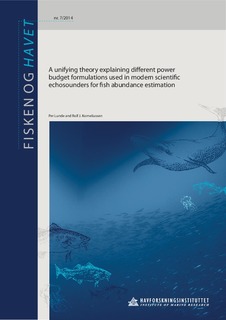| dc.contributor.author | Lunde, Per | |
| dc.contributor.author | Korneliussen, Rolf J. | |
| dc.date.accessioned | 2016-01-19T09:02:43Z | |
| dc.date.available | 2016-01-19T09:02:43Z | |
| dc.date.issued | 2014-12-31 | |
| dc.identifier.issn | 0071-5638 | |
| dc.identifier.uri | http://hdl.handle.net/11250/2374177 | |
| dc.description.abstract | Acoustic methods used in fish abundance estimation constitute a key part of the analytic assessment that makes
the basis for fisheries research and international regulations of marine resources. The methods rely on power
budget equations and calibrated systems. Different instrument specific formulations of power budget equations
and calibration factors are used in modern scientific echosounder and sonar systems, such as the Simrad
EK500 and the more recent Simrad EK60, ES60, ME70 and MS70 systems. These are instruments extensively
used internationally for such applications, over the last decade or more. However, the lack of sufficient
documentation in prior literature, on the actual power budget equations and calibration factors employed in
these instruments, and their relationships to the traditional theory of fish abundance measurement, has caused
some uncertainty and confusion among users. Control with systematic errors and drift demands the functional
relationship of the abundance measurement to be fully known in terms of the electrical and acoustical
parameters of the system used. The paper presents a unifying theory which seems to explain the different
(instrument specific) power budget equation formulations and calibration factors employed in the mentioned
echosounder and sonar systems, how they are related, and their relationship to the traditional and generic
(instrument independent) theory of fish abundance measurement. Inconsistencies in prior literature are
explained and corrected. Prior literature on the traditional theory is extended to provide more complete power
budget equations for fish abundance estimation and species identification, by accounting for electrical
termination, representation of echo integration, and the full range of electrical and acoustical echosounder
parameters. These extensions apply both to the instrument specific and the generic instrument independent
formulations. The expressions derived here provide a consistent and relatively complete theoretical basis for
improved understanding and control in use of conventional methods and instruments for fish abundance
measurement and species identification employed today. | nb_NO |
| dc.description.abstract | Akustiske metoder for mengdemåling av fisk representerer et nøkkelelement innen den teknologiske basis for
moderne fiskeriforskning og internasjonal regulering av marine ressurser. Akustiske metoder er basert på bruk
av effektbudsjett-ligninger og kalibrerte ekkolodd-system. Ulike instrument-spesifikke formuleringer av
effektbudsjett-ligninger og kalibreringsfaktorer benyttes i moderne vitenskapelige ekkolodd og sonarsystemer,
så som Simrad EK500 og de nyere Simrad EK60, ES60, ME70, og MS70 - systemene. Dette er instrumenter
som over de senere tiår i utstrakt grad er benyttet internasjonalt for slike anvendelser. Mangel på tilstrekkelig
dokumentasjon i tidligere litteratur, vedrørende de aktuelle effektbudsjett-ligningene og kalibreringsfaktorene
som benyttes i disse instrumentene, og deres sammenheng med den tradisjonelle teorien for mengdemåling av
fisk, har forårsaket noe usikkerhet og forvirring blant brukere av slike systemer. Kontroll med systematiske feil
og drift i slike instrumenter, forutsetter at mest mulig fullstendige matematiske funksjonsuttrykk for
bestandsestimering er kjent, i form av de elektriske og akustiske parametre som benyttes i aktuelle systemer.
Rapporten presenterer en enhetlig teori som ser ut til å kunne forklare de ulike (instrument-spesifikke)
effektbudsjett-ligningene og kalibreringsfaktorene som benyttes i ekkolodd- og sonarsystemer. Dette
inkluderer hvordan funksjonsuttrykkene som er brukt i disse instrumentene er relatert, samt deres sammenheng
med den tradisjonelle og generiske (instrument-uavhengige) teorien for bestandsestimering av fisk.
Inkonsistens i tidligere litteratur er forklart og korrigert. Tradisjonell teori for mengemåling av fisk er
videreutviklet og generalisert til å dekke mer fullstendige effektbudsjett-likninger for bestandsestimering og
artsgjenkjennelse, ved å ivareta elektrisk terminering, representasjon av ekko-integrasjon, og de aktuelle
elektriske og akustiske ekkolodd-parametre. Slik videreutvikling innbefatter både de instrument-spesifikke og
de instrument-uavhengige (generiske) formuleringene. De funksjonsuttrykk som blir utledet her, utgjør en
konsistent og relativt komplett teoretisk basis for forbedret forståelse og kontroll, i bruk av de konvensjonelle
metoder og instrumenter for mengdemåling og artsgjenkjennelse av fisk som benyttes i dag. | nb_NO |
| dc.language.iso | eng | nb_NO |
| dc.publisher | Havforskningsinstituttet | nb_NO |
| dc.relation.ispartofseries | Fisken og Havet;7-2014 | |
| dc.subject | acoustics | nb_NO |
| dc.subject | akustikk | nb_NO |
| dc.subject | echo sounder | nb_NO |
| dc.subject | ekolodd | nb_NO |
| dc.title | A unifying theory explaining different power budget formulations used in modern scientific echosounders for fish abundance estimation | nb_NO |
| dc.title.alternative | En enhetlig teori som forener ulike effektbudsjettformuleringer brukt i moderne vitenskapelige ekkolodd for akustisk bestandsestimering av fisk | nb_NO |
| dc.type | Research report | nb_NO |
| dc.subject.nsi | VDP::Mathematics and natural science: 400::Physics: 430::Electromagnetism, acoustics, optics: 434 | nb_NO |
| dc.subject.nsi | VDP::Agriculture and fishery disciplines: 900::Fisheries science: 920::Resource biology: 921 | nb_NO |
| dc.source.pagenumber | 34 s. | nb_NO |
